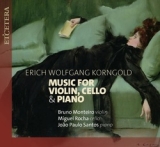Nach der vorhergehenden CD mit Werken von Chausson und Ysaÿe legen die als Trio oder Duo spielenden Musiker nun ihre Sicht zu Erich Wolfgang Korngold vor. Es bleibt dabei, dass die Musiker bereits im Trio wieder mit Leidenschaft ans Werk gehen und eine vitale Deutung des ersten Satzes vorlegen. Und diese investierte Energie ist sicherlich ein Pluspunkt. Im folgenden Scherzo wird die Vitalität und mit dem Walzerteil die Nähe zur Musik Österreichs deutlich. Die drei Musiker bieten ein eher robustes Bild dieses Tanztyps. Im Trio – Larghetto fällt besonders auf, dass die Technik die Musiker alle mit gleichem Gewicht eingefangen hat. So wird jeder hörbar und keiner sitzt im akustischen Schatten. Im Finale wird wieder nicht mit Energie gegeizt, teilweise ein wenig überpointiert.
Rund und gefällig erklingt der Kopfsatz der Violinsonate. Das Scherzo an zweiter Stelle bietet der Geigenstimme ausgeprägte Tonketten, während später mehr lyrische Passagen erklingen. Im von Strauss und Mahler beeinflussten, aber mit Korngolds einzigartiger musikalischer Sprache geschriebenen Adagio werden Reihen chromatischer Harmonien erkundet. Das gelingt Bruno Monteiro in sorgfältig ausgearbeiteter Manier. Der Finalsatz schließt das Werk wiederum mit intensiv ausgeprägter Gestaltung durch die Interpreten.
Im Tanzlied des Pierrot aus der Oper „Die tote Stadt“ darf dann noch Cellist Miguel Rocha sein Können hören lassen. Mit sonorem Feinklang bietet er eine einnehmende Interpretation dieses Salonstückes an und kann deshalb einen sehr guten Eindruck hinterlassen.
Das sichere, gut organisierte und sensible sowie auf die Partner abgestimmte Spiel des Pianisten João Paulo Santos darf noch als weiteres Positivum erwähnt werden.
After the previous CD with works by Chausson and Ysaÿe, the musicians playing as a trio or duo now present their view on Erich Wolfgang Korngold.
It remains that already in the trio the musicians show passion and present a vital interpretation of the first movement. And this invested energy is certainly a plus. In the following Scherzo the vitality and with the waltz part the closeness to the music of Austria becomes clear. The three musicians offer rather a robust picture of this type of dance. In the Trio – Larghetto it is particularly noticeable that the technique has captured the musicians all with equal weight. Thus everyone becomes audible and no one sits in the acoustic shadow. In the finale, there is again no stinginess with energy, sometimes a bit over-pointed.
The opening movement of the violin sonata sounds round and pleasing. The Scherzo in second place offers the violin part distinct chains of notes, while later more lyrical passages are heard. In the Adagio, influenced by Strauss and Mahler but written with Korngold’s unique musical language, rows of chromatic harmonies are explored. Bruno Monteiro succeeds in this in a carefully crafted manner. The final movement again closes the work with intensely distinctive shaping by the performers.
In the dance song of Pierrot from the opera « The Dead City », cellist Miguel Rocha lets his skills be heard. With sonorous fine sound he offers an engaging interpretation of this salon piece and can therefore leave a very good impression.
The secure, well-organized and sensitive playing of pianist João Paulo Santos, which is attuned to the partners, may be mentioned as a further positive aspect.
























